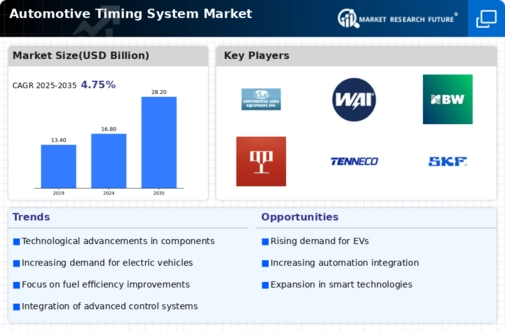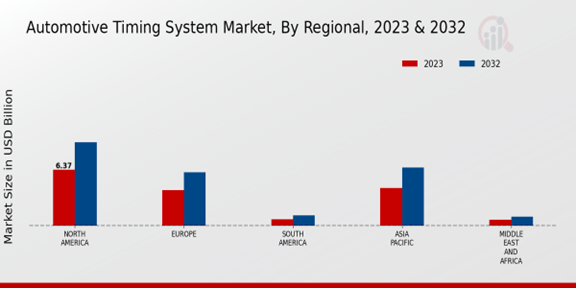Market Growth Projections
The Global Automotive Timing System Market Industry is anticipated to experience substantial growth over the next decade. Projections indicate that the market will reach 16.8 USD Billion in 2024 and expand to 28.2 USD Billion by 2035, reflecting a compound annual growth rate of 4.83% from 2025 to 2035. This growth trajectory suggests a robust demand for advanced timing systems, driven by technological innovations, regulatory pressures, and changing consumer preferences. The market's expansion is likely to create new opportunities for manufacturers and suppliers in the automotive sector.
Growing Demand for Fuel Efficiency
The increasing emphasis on fuel efficiency among consumers and manufacturers is a primary driver for the Global Automotive Timing System Market Industry. As automotive manufacturers strive to meet stringent emissions regulations, the demand for advanced timing systems that optimize engine performance is rising. These systems play a crucial role in enhancing fuel economy, which is particularly relevant as the market is projected to reach 16.8 USD Billion in 2024. This trend indicates a shift towards more sustainable automotive technologies, which could further propel the market as consumers become more environmentally conscious.
Increase in Electric Vehicle Production
The surge in electric vehicle (EV) production is reshaping the Global Automotive Timing System Market Industry. As manufacturers pivot towards electric and hybrid vehicles, the demand for innovative timing systems that cater to these new powertrains is likely to increase. Although traditional timing systems are essential for internal combustion engines, the adaptation of these systems for electric vehicles presents new opportunities for growth. The market's expansion is expected to align with the overall automotive industry's transition towards electrification, potentially influencing market dynamics in the coming years.
Technological Advancements in Engine Design
Technological innovations in engine design are significantly influencing the Global Automotive Timing System Market Industry. The introduction of variable valve timing and other advanced mechanisms enhances engine efficiency and performance. These advancements allow for better control of engine timing, leading to improved power output and reduced emissions. As the market evolves, it is anticipated that these technologies will contribute to the market's growth, with projections indicating a rise to 28.2 USD Billion by 2035. This growth reflects the industry's commitment to integrating cutting-edge technologies into automotive systems.
Regulatory Compliance and Emission Standards
Stringent regulatory compliance and evolving emission standards are pivotal drivers of the Global Automotive Timing System Market Industry. Governments worldwide are enforcing stricter regulations to curb vehicle emissions, prompting manufacturers to adopt advanced timing systems that enhance engine efficiency. This regulatory landscape compels automotive companies to innovate continuously, ensuring their products meet compliance requirements. As a result, the market is poised for growth, with a compound annual growth rate of 4.83% projected from 2025 to 2035. This trend underscores the importance of timing systems in achieving regulatory compliance.
Rising Consumer Awareness of Engine Performance
Rising consumer awareness regarding engine performance and its impact on vehicle longevity is influencing the Global Automotive Timing System Market Industry. Consumers are increasingly seeking vehicles that offer superior performance, reliability, and efficiency. This shift in consumer preferences drives manufacturers to invest in advanced timing systems that enhance engine performance and reduce maintenance costs. As the market evolves, this growing awareness is expected to contribute to the overall market growth, aligning with the projected increase in market value to 28.2 USD Billion by 2035.


















Leave a Comment